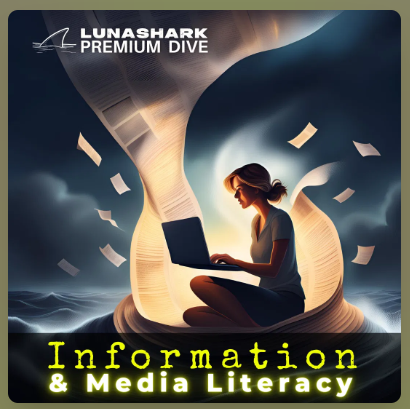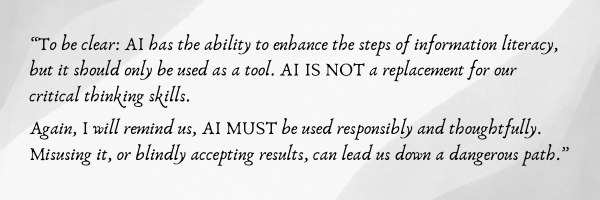Long Time, New Skills: My Dive into Podcasting and AI
Long Time, No Post – But Here’s Why!
Well… hello again! It’s been a wild few months, both personally and professionally, and I’m finally catching my breath. On the professional front, I’ve been diving into something I never thought I’d do: writing and recording deep dive episodes for LUNASHARK Media’s premium members. That’s right: podcast episodes. Researching, scripting, and recording?! A few months ago, I wouldn’t have believed it. Huge thanks to Mandy, David, and the entire LUNASHARK team for giving me the chance to stretch my skills in a big way.
My first topic? One that’s super close to my heart: information literacy. I tackled it in two parts: first paired with media literacy, and then explored its intersection with artificial intelligence (AI).
(Check out the images below for links to audio snap shots from both episodes!)
Information & Media Literacy Part One: News, Noise, and Navigating the Truth
Audio excerpt from LUNASHARK Media’s Instagram Page
Information & Media Literacy Part Two: Decoding AI’s Tools, Truths, and Responsible Use
Audio excerpt from LUNASHARK Media’s Instagram Page
Now, let’s talk about AI.
When I started researching, I knew the basics . . . maybe. AI was this mysterious, slightly intimidating topic. Fast forward a bit, and I’ve learned a lot. And because it’s something affecting how we all find, share, and evaluate information, I want to share a bit of what I’ve uncovered, especially how it ties directly into information literacy.
So, What IS AI exactly?
Artificial Intelligence isn’t sci-fi anymore. It’s everywhere, shaping the way we drive, shop, scroll, search, and interact. From Siri and Alexa to the algorithms feeding you movie recommendations, AI is working quietly (and sometimes loudly) in the background of our lives.
Experts often break AI into four main categories:
Reactive – These don’t learn or remember. Think: Netflix suggestions or email spam filters.
Limited Memory – These do learn and adapt. Self-driving cars, smart assistants, and ChatGPT fall here.
Theory of Mind – A theoretical concept that would allow AI to understand emotions, beliefs, and intentions.
Self-Aware – Still science fiction (and maybe for the best!).
Right now, the AIs we interact with daily are mostly reactive or limited memory types.
The Good, The Bad, and the “Wait, What?”
AI is powerful—and with that comes potential and pitfalls. Here’s a quick breakdown:
Pros of AI:
Time-Saver Extraordinaire: AI helps with everything from transcription to brainstorming, legal research, and even planning your move. I used ChatGPT to create a moving schedule for me based on how many rooms I had to pack and my deadline.
Accessibility Win: Tools like text-to-speech and translation apps help break language and ability barriers.
Fresh Educational Paths: With AI, educators can shift focus from what students create to how they think through problems.
Research Made Easier: Summarizing articles? Finding patterns in messy data? AI’s got your back.
Cons of AI:
AI “Hallucinations”: Just because an answer sounds right doesn’t mean it is. Fact-checking is non-negotiable.
Data Privacy Concerns: Be careful with what info you feed AI tools, especially sensitive or personal data.
Environmental Footprint: AI uses a ton of energy, especially large models that run 24/7.
Intellectual Property Drama: AI pulls from the internet, and sometimes steps on creators’ toes in the process.
Laws Are Lagging: Regulation is catching up slowly. Until then, the ethical burden falls on users.
Bias & Misinformation: If trained on biased data, AI can reinforce stereotypes or spread false information, like eerily realistic deepfakes.
Where AI Meets Information Literacy
This is where things get really interesting for me! Information literacy means knowing how to identify, find, evaluate, apply, and acknowledge information responsibly. AI can help with all of that, but only if we approach it thoughtfully:
Identify: Not sure how to get started? Ask AI to brainstorm or narrow your focus.
Find: AI can suggest search strategies or relevant sources, just remember to check its references.
Evaluate: AI is great for summarizing content and saving time, but it’s not always accurate. Like Wikipedia, it’s a helpful starting point, but critical facts should always be verified.
Apply: AI can assist with brainstorming and organizing data, but it can’t make decisions for us. Applying information thoughtfully is still a human job—and using AI responsibly is key.
Acknowledge: If AI helped you write, research, or design, say so (Thanks, AI for your help). Transparency matters. Academic and professional circles now recommend an AI Disclosure section for any work using these tools.
I think this is my favorite excerpt from part two:
“To be clear: AI has the ability to enhance the steps of information literacy, but it should only be used as a tool. AI IS NOT a replacement for our critical thinking skills. Again, I will remind us, AI MUST be used responsibly and thoughtfully. Misusing it, or blindly accepting results, can lead us down a dangerous path.”
So, What’s the Takeaway?
AI isn’t going anywhere. Whether you’re all-in or skeptical, understanding AI is part of modern information literacy. The more we know about how it works, the smarter and safer we’ll be as we navigate our tech-driven world.
And yes, let me say it one more time (because I definitely said it a lot in Part Two): we have to use AI responsibly.
We don’t have to be tech geniuses to stay informed. We just need to stay curious, stay critical, and keep asking smart questions.

